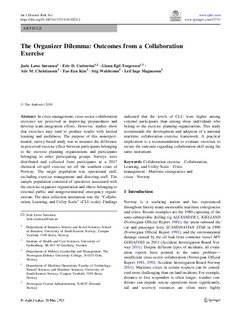| dc.contributor.author | Sørensen, Jarle Løwe | |
| dc.contributor.author | Carlström, Eric | |
| dc.contributor.author | Torgersen, Glenn-Egil | |
| dc.contributor.author | Christiansen, Atle Martin | |
| dc.contributor.author | Kim, Tae-Eun | |
| dc.contributor.author | wahlstrøm, Stig | |
| dc.contributor.author | Magnussen, Leif Inge | |
| dc.date.accessioned | 2019-05-28T08:03:18Z | |
| dc.date.available | 2019-05-28T08:03:18Z | |
| dc.date.created | 2019-05-23T19:37:01Z | |
| dc.date.issued | 2019 | |
| dc.identifier.citation | International Journal of Disaster Risk Science. 2019, 1-9. | nb_NO |
| dc.identifier.issn | 2095-0055 | |
| dc.identifier.uri | http://hdl.handle.net/11250/2599133 | |
| dc.description | his article is distributed under the terms of the Creative Commons Attribution 4.0 | nb_NO |
| dc.description.abstract | In crisis management, cross-sector collaboration exercises are perceived as improving preparedness and develop team-integration efforts. However, studies show that exercises may tend to produce results with limited learning and usefulness. The purpose of this nonexperimental, survey-based study was to measure the difference in perceived exercise effect between participants belonging to the exercise planning organizations and participants belonging to other participating groups. Surveys were distributed and collected from participants in a 2017 chemical oil-spill exercise set off the southern coast of Norway. The target population was operational staff, excluding exercise management and directing staff. The sample population consisted of operatives associated with the exercise organizer organization and others belonging to external public and nongovernmental emergency organizations. The data collection instrument was the “Collaboration, Learning, and Utility Scale” (CLU-scale). Findings indicated that the levels of CLU were higher among external participants than among those individuals who belong to the exercise planning organizations. This study recommends the development and adoption of a national maritime collaboration exercise framework. A practical implication is a recommendation to evaluate exercises to secure the outcome regarding collaboration skill using the same instrument. | nb_NO |
| dc.language.iso | eng | nb_NO |
| dc.rights | Navngivelse 4.0 Internasjonal | * |
| dc.rights.uri | http://creativecommons.org/licenses/by/4.0/deed.no | * |
| dc.title | The Organizer Dilemma: Outcomes from a Collaboration Exercise | nb_NO |
| dc.type | Journal article | nb_NO |
| dc.type | Peer reviewed | nb_NO |
| dc.description.version | publishedVersion | nb_NO |
| dc.rights.holder | © The Author(s) 2019 | nb_NO |
| dc.source.pagenumber | 1-9 | nb_NO |
| dc.source.journal | International Journal of Disaster Risk Science | nb_NO |
| dc.identifier.doi | 10.1007/s13753-019-0220-2 | |
| dc.identifier.cristin | 1699917 | |
| cristin.unitcode | 222,57,4,0 | |
| cristin.unitcode | 222,58,0,0 | |
| cristin.unitname | Institutt for økonomi, historie og samfunnsvitenskap | |
| cristin.unitname | Fakultet for teknologi, naturvitenskap og maritime fag | |
| cristin.ispublished | true | |
| cristin.fulltext | original | |
| cristin.qualitycode | 1 | |

